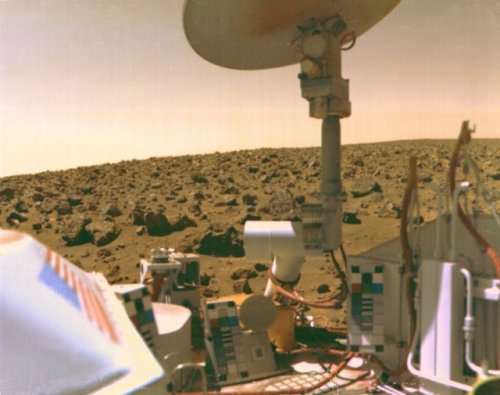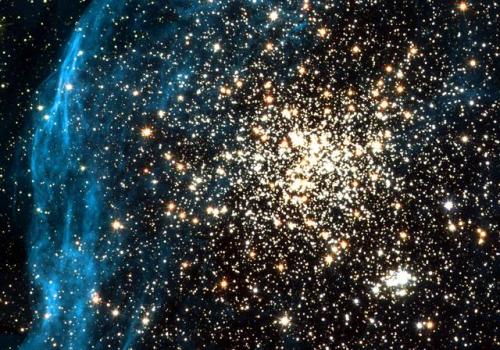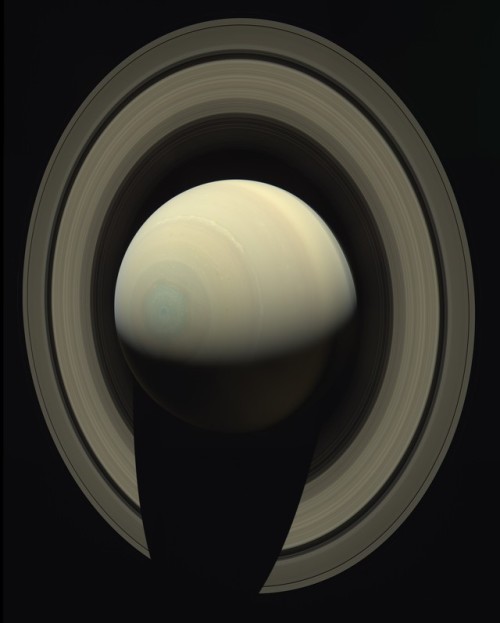Xyhor-astronomy - Xpand Your Horizons W/ Astronomy & Spacefaring
More Posts from Xyhor-astronomy and Others

A boulder-strewn field of red rocks stretches across the horizon in this self-portrait of Viking 2 on Mars’ Utopian Plain. Viking 2 landed Sept. 3,1976, some 4,600 miles from the twin Viking 1 craft, which touched down on July 20.
Image Credit: NASA/JPL

Located in the Large Magellanic Cloud, one of our neighbouring dwarf galaxies, this young globular-like star cluster is surrounded by a pattern of filamentary nebulosity that is thought to have been created during supernova blasts. It consists of a main globular cluster in the centre and a younger, smaller cluster, seen below and to the right, composed of extremely hot, blue stars and fainter, red T-Tauri stars. This wide variety of stars allows a thorough study of star formation processes.
Credit: ESA, NASA and Martino Romaniello (ESO, Germany)
Solar System: 10 Things to Know This Week
Need some space?
Here are 10 perspective-building images for your computer desktop and mobile device wallpaper.
These are all real images, sent very recently by our planetary missions throughout the solar system.
1. Our Sun

Warm up with this view from our Solar Dynamics Observatory showing active regions on the Sun in October 2017. They were observed in a wavelength of extreme ultraviolet light that reveals plasma heated to over a million degrees.
Downloads Desktop: 1280 x 800 | 1600 x 1200 | 1920 x 1200 Mobile: 1440 x 2560 | 1080 x 1920 | 750 x 1334
2. Jupiter Up-Close

This series of enhanced-color images shows Jupiter up close and personal, as our Juno spacecraft performed its eighth flyby of the gas giant planet on Sept. 1, 2017.
Downloads Desktop: 1280 x 800 | 1600 x 1200 | 1920 x 1200 Mobile: 1440 x 2560 | 1080 x 1920 | 750 x 1334
3. Saturn’s and Its Rings

With this mosaic from Oct. 28, 2016, our Cassini spacecraft captured one of its last looks at Saturn and its main rings from a distance.
Downloads Desktop: 1280 x 800 | 1600 x 1200 | 1920 x 1200 Mobile: 1440 x 2560 | 1080 x 1920 | 750 x 1334
4. Gale Crater on Mars

This look from our Curiosity Mars rover includes several geological layers in Gale crater to be examined by the mission, as well as the higher reaches of Mount Sharp beyond. The redder rocks of the foreground are part of the Murray formation. Pale gray rocks in the middle distance of the right half of the image are in the Clay Unit. A band between those terrains is “Vera Rubin Ridge,” where the rover is working currently. The view combines six images taken with the rover’s Mast Camera (Mastcam) on Jan. 24, 2017.
Downloads Desktop: 1280 x 800 | 1600 x 1200 | 1920 x 1200 Mobile: 1440 x 2560 | 1080 x 1920 | 750 x 1334
5. Sliver of Saturn

Cassini peers toward a sliver of Saturn’s sunlit atmosphere while the icy rings stretch across the foreground as a dark band on March 31, 2017. This view looks toward the unilluminated side of the rings from about 7 degrees below the ring plane.
Downloads Desktop: 1280 x 800 | 1600 x 1200 | 1920 x 1200 Mobile: 1440 x 2560 | 1080 x 1920 | 750 x 1334
6. Dwarf Planet Ceres

This image of the limb of dwarf planet Ceres shows a section of the northern hemisphere, as seen by our Dawn mission. Prominently featured is Occator Crater, home of Ceres’ intriguing “bright spots.” The latest research suggests that the bright material in this crater is comprised of salts left behind after a briny liquid emerged from below.
Downloads Desktop: 1280 x 800 | 1600 x 1200 | 1920 x 1200 Mobile: 1440 x 2560 | 1080 x 1920 | 750 x 1334
7. Martian Crater

This image from our Mars Reconnaissance Orbiter (MRO) shows a crater in the region with the most impressive known gully activity in Mars’ northern hemisphere. Gullies are active in the winter due to carbon dioxide frost, but northern winters are shorter and warmer than southern winters, so there is less frost and less gully activity.
Downloads Desktop: 1280 x 800 | 1600 x 1200 | 1920 x 1200 Mobile: 1440 x 2560 | 1080 x 1920 | 750 x 1334
8. Dynamic Storm on Jupiter

A dynamic storm at the southern edge of Jupiter’s northern polar region dominates this Jovian cloudscape, courtesy of Juno. This storm is a long-lived anticyclonic oval named North North Temperate Little Red Spot 1. Citizen scientists Gerald Eichstädt and Seán Doran processed this image using data from the JunoCam imager.
Downloads Desktop: 1280 x 800 | 1600 x 1200 | 1920 x 1200 Mobile: 1440 x 2560 | 1080 x 1920 | 750 x 1334
9. Rings Beyond Saturn’s Sunlit Horizon

This false-color view from the Cassini spacecraft gazes toward the rings beyond Saturn’s sunlit horizon. Along the limb (the planet’s edge) at left can be seen a thin, detached haze.
Downloads Desktop: 1280 x 800 | 1600 x 1200 | 1920 x 1200 Mobile: 1440 x 2560 | 1080 x 1920 | 750 x 1334
10. Saturn’s Ocean-Bearing Moon Enceladus

Saturn’s active, ocean-bearing moon Enceladus sinks behind the giant planet in a farewell portrait from Cassini. This view of Enceladus was taken by NASA’s Cassini spacecraft on Sept. 13, 2017. It is among the last images Cassini sent back before its mission came to an end on Sept. 15, after nearly 20 years in space.
Downloads Desktop: 1280 x 800 | 1600 x 1200 | 1920 x 1200 Mobile: 1440 x 2560 | 1080 x 1920 | 750 x 1334
Applying Wallpaper: 1. Click on the screen resolution you would like to use. 2. Right-click on the image (control-click on a Mac) and select the option ‘Set the Background’ or 'Set as Wallpaper’ (or similar).
Places to look for more of our pictures include solarsystem.nasa.gov/galleries, images.nasa.gov and www.jpl.nasa.gov/spaceimages.
Make sure to follow us on Tumblr for your regular dose of space: http://nasa.tumblr.com
Chasing the Shadow of Neptune’s Moon Triton
Our Flying Observatory

Our flying observatory, called SOFIA, carries a 100-inch telescope inside a Boeing 747SP aircraft. Scientists onboard study the life cycle of stars, planets (including the atmosphere of Mars and Jupiter), nearby planetary systems, galaxies, black holes and complex molecules in space.
AND in just a few days SOFIA is going on a special flight to chase the shadow of Neptune’s moon Triton as it crosses Earth’s surface!
In case you’re wondering, SOFIA stands for: Stratospheric Observatory for Infrared Astronomy.
Triton

Triton is 1,680 miles (2,700 km) across, making it the largest of the 13 moons orbiting Neptune. Unlike most large moons in our solar system, Triton orbits in the opposite direction of Neptune, called a retrograde orbit. This backward orbit leads scientists to believe that Triton formed in an area past Neptune, called the Kuiper Belt, and was pulled into its orbit around Neptune by gravity.
The Voyager 2 spacecraft flew past Neptune and Triton in 1989 and found that Triton’s atmosphere is made up of mostly nitrogen…but it has not been studied in nearly 16 years!
Occultations are Eclipse-Like Events

An occultation occurs when an object, like a planet or a moon, passes in front of a star and completely blocks the light from that star. As the object blocks the star’s light, it casts a faint shadow on Earth’s surface.
But unlike an eclipse, these shadows are not usually visible to the naked eye because the star and object are much smaller and not nearly as bright as our sun. Telescopes with special instruments can actually see these shadows and study the star’s light as it passes near and around the object – if they can be in the right place on Earth to catch the shadow.
Chasing Shadows

Scientists have been making advanced observations of Triton and a background star. They’ve calculated exactly where Triton’s faint shadow will fall on Earth! Our SOFIA team has designed a flight path that will put SOFIA (the telescope and aircraft) exactly in the center of the shadow at the precise moment that Triton and the star will align.
This is no easy feat because the shadow is moving at more than 53,000 mph while SOFIA flies at Mach 0.85 (652 mph), so we only have about two minutes to catch the shadow!! But our SOFIA team has previously harnessed the aircraft’s mobility to study Pluto from inside the center of its occultation shadow, and is ready to do it again to study Triton!
What We Learn From Inside the Shadow

From inside the shadow, our team on SOFIA will study the star’s light as it passes around and through Triton’s atmosphere. This allows us to learn more about Triton’s atmosphere, including its temperature, pressure, density and composition!
Our team will use this information to examine if Triton’s atmosphere has changed since our Voyager 2 spacecraft flew past it in 1989. That’s a lot of information from a bit of light inside a shadow! Similar observations of Uranus in 1977, from our previous flying observatory, led to the discovery of rings around that planet!
International Ground-Based Support

Ground-based telescopes across the United States and Europe – from Scotland to the Canary Islands – will also be studying Triton’s occultation. Even though most of these telescopes will not be in the center of the shadow, the simultaneous observations, from different locations on Earth, will give us information about how Triton’s atmosphere varies across its latitudes.
This data from across the Earth and from onboard SOFIA will help researchers understand how Triton’s atmosphere is distorted at different locations by its high winds and its strong tides!
Make sure to follow us on Tumblr for your regular dose of space: http://nasa.tumblr.com.

Image of Titan taken by the Cassini spacecraft
NASA/JPL-Caltech/SSI/Kevin M. Gill

Image of Saturn taken by the Cassini spacecraft in 2013
Image credit: NASA / JPL-Caltech

Should there be a holiday called Astronomy Day?
Where lights are to be turned off for the entire night so everyone could see the stars?
To Scale Solar System Replica in the Desert!

Hubble peeks inside a stellar cloud
These bright stars shining through what looks like a haze in the night sky are part of a young stellar grouping in one of the largest known star formation regions of the Large Magellanic Cloud (LMC), a dwarf satellite galaxy of the Milky Way. The image was captured by the NASA/ESA Hubble Space Telescope’s Wide Field Planetary Camera 2.
The stellar grouping is known to stargazers as NGC 2040 or LH 88. It is essentially a very loose star cluster whose stars have a common origin and are drifting together through space. There are three different types of stellar associations defined by their stellar properties. NGC 2040 is an OB association, a grouping that usually contains 10–100 stars of type O and B — these are high-mass stars that have short but brilliant lives. It is thought that most of the stars in the Milky Way were born in OB associations.
There are several such groupings of stars in the LMC, including one previously featured as a Hubble Picture of the Week. Just like the others, LH 88 consists of several high-mass young stars in a large nebula of partially ionised hydrogen gas, and lies in what is known to be a supergiant shell of gas called LMC 4.
Over a period of several million years, thousands of stars may form in these supergiant shells, which are the largest interstellar structures in galaxies. The shells themselves are believed to have been created by strong stellar winds and clustered supernova explosions of massive stars that blow away surrounding dust and gas, and in turn trigger further episodes of star formation.
The LMC is the third closest galaxy to our Milky Way. It is located some 160 000 light-years away, and is about 100 times smaller than our own.
This image, which shows ultraviolet, visible and infrared light, covers a field of view of approximately 1.8 by 1.8 arcminutes.
A version of this image was entered into the Hubble’s Hidden Treasures Image Processing Competition by contestant Eedresha Sturdivant. Hidden Treasures is an initiative to invite astronomy enthusiasts to search the Hubble archive for stunning images that have never been seen by the general public.
These bright stars shining through what looks like a haze in the night sky are part of a young stellar grouping in one of the largest known star formation regions of the Large Magellanic Cloud (LMC), a dwarf satellite galaxy of the Milky Way. The image was captured by the NASA/ESA Hubble Space Telescope’s Wide Field Planetary Camera 2.
The stellar grouping is known to stargazers as NGC 2040 or LH 88. It is essentially a very loose star cluster whose stars have a common origin and are drifting together through space. There are three different types of stellar associations defined by their stellar properties. NGC 2040 is an OB association, a grouping that usually contains 10–100 stars of type O and B — these are high-mass stars that have short but brilliant lives. It is thought that most of the stars in the Milky Way were born in OB associations.
There are several such groupings of stars in the LMC, including one previously featured as a Hubble Picture of the Week. Just like the others, LH 88 consists of several high-mass young stars in a large nebula of partially ionised hydrogen gas, and lies in what is known to be a supergiant shell of gas called LMC 4.
Over a period of several million years, thousands of stars may form in these supergiant shells, which are the largest interstellar structures in galaxies. The shells themselves are believed to have been created by strong stellar winds and clustered supernova explosions of massive stars that blow away surrounding dust and gas, and in turn trigger further episodes of star formation.
The LMC is the third closest galaxy to our Milky Way. It is located some 160 000 light-years away, and is about 100 times smaller than our own.
This image, which shows ultraviolet, visible and infrared light, covers a field of view of approximately 1.8 by 1.8 arcminutes.
A version of this image was entered into the Hubble’s Hidden Treasures Image Processing Competition by contestant Eedresha Sturdivant. Hidden Treasures is an initiative to invite astronomy enthusiasts to search the Hubble archive for stunning images that have never been seen by the general public.
ESA/Hubble, NASA and D. A Gouliermis. Acknowledgement: Flickr user Eedresha Sturdivant
https://www.spacetelescope.org/images/potw

ON THIS DAY: An impressive impact crater on Mars, observed by NASA’s Mars Reconnaissance Orbiter, November 19, 2013. (NASA)
-
 xyhor-astronomy reblogged this · 7 years ago
xyhor-astronomy reblogged this · 7 years ago
For more content, Click Here and experience this XYHor in its entirety!Space...the Final Frontier. Let's boldly go where few have gone before with XYHor: Space: Astronomy & Spacefaring: the collection of the latest finds and science behind exploring our solar system, how we'll get there and what we need to be prepared for!
128 posts